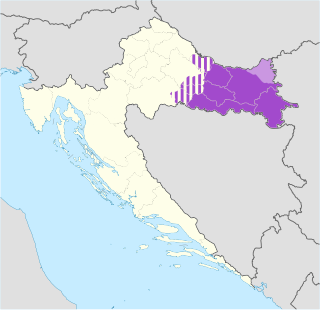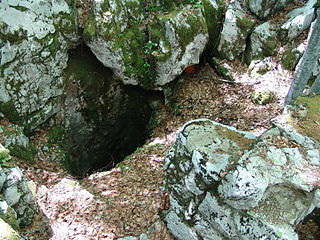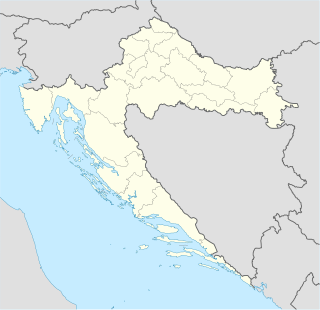
Jasenovac was a concentration and extermination camp established in Slavonia by the authorities of the Independent State of Croatia (NDH) during World War II. The concentration camp, one of the ten largest in Europe, was established and operated by the governing Ustaše regime, which was the only quisling regime in occupied Europe to operate extermination camps solely on their own for Jews and other ethnic groups.

Slavonia is, with Dalmatia, Croatia proper and Istria, one of the four historical regions of Croatia. Taking up the east of the country, it roughly corresponds with five Croatian counties: Brod-Posavina, Osijek-Baranja, Požega-Slavonia, Virovitica-Podravina and Vukovar-Syrmia, although the territory of the counties includes Baranya, and the definition of the western extent of Slavonia as a region varies. The counties cover 12,556 square kilometres or 22.2% of Croatia, inhabited by 806,192—18.8% of Croatia's population. The largest city in the region is Osijek, followed by Slavonski Brod and Vinkovci.

Valpovo is a town in Slavonia, Croatia. It is close to the Drava river in the region of Slavonia, 25 km (16 mi) northwest of Osijek. The population of Valpovo is 7,406, with a total of 11,563 in the municipality.

The Independent State of Croatia was a World War II-era puppet state of Nazi Germany and Fascist Italy. It was established in parts of occupied Yugoslavia on 10 April 1941, after the invasion by the Axis powers. Its territory consisted of most of modern-day Croatia and Bosnia and Herzegovina, as well as some parts of modern-day Serbia and Slovenia, but also excluded many Croat-populated areas in Dalmatia, Istria, and Međimurje regions.
The Bleiburg repatriations occurred in May 1945, at the end of World War II in Europe. Tens of thousands of soldiers and civilians associated with the Axis powers fled Yugoslavia to Austria as the Soviet Union and Yugoslav Partisans took control. When they reached Austria, the British refused to accept their surrender and directed them to the Partisans instead. The soldiers and others were subjected to forced marches, together with columns captured by other Partisans in Yugoslavia. Tens of thousands of these men were executed; others were taken to forced labor camps, where more died from harsh conditions. The events are named for the Carinthian border town of Bleiburg, where the initial repatriation was conducted.

World War II military operations in Yugoslavia began on 6 April 1941, when the Kingdom of Yugoslavia was swiftly conquered by Axis forces and partitioned between Germany, Italy, Hungary, Bulgaria and client regimes. Subsequently, a guerrilla liberation war was fought against the Axis occupying forces and their locally established puppet regimes, including the fascist Independent State of Croatia (NDH) and the Government of National Salvation in the German-occupied territory of Serbia, by the communist-led republican Yugoslav Partisans. Simultaneously, a multi-side civil war was waged between the Yugoslav communist Partisans, the Serbian royalist Chetniks, the Croatian fascist Ustashe and Home Guard, Serbian Volunteer Corps and State Guard, as well as Slovene Home Guard troops.
In Croatia, there are over 2,900 people who consider themselves German, most of these Danube Swabians. Germans are officially recognized as an autochthonous national minority, and as such, they elect a special representative to the Croatian Parliament, shared with members of eleven other national minorities. They are mainly concentrated in the area around Osijek in eastern Slavonia.
Alka Vuica is a Croatian singer, lyricist and tv presenter. Her musical style can be described as a mixture of pop and local folk.

Viktor Axmann was a Croatian architect. He spent most of his life in Osijek, but he died in 1946 in a communist labor camp in Valpovo.

The Jadovno concentration camp was a concentration and extermination camp in the Independent State of Croatia (NDH) during World War II. Commanded by Juco Rukavina, it was the first of twenty-six concentration camps in the NDH during the war. Established in a secluded area about 20 kilometres (12 mi) from the town of Gospić, it held thousands of Serbs and Jews over a period of 122 days from May to August 1941. Inmates were usually killed by being pushed into deep ravines located near the camp. Estimates of the number of deaths at Jadovno range from 10,000 to 68,000, mostly Serbs. The camp was closed on 21 August 1941, and the area where it was located was later handed over to the Kingdom of Italy and became part of Italian Zones II and III. Jadovno was replaced by the greater sized Jasenovac concentration camp and its extermination facilities.

The Holocaust in the Independent State of Croatia is a term which is primarily used in reference to the genocide of Jews, but sometimes, it is also used in reference to the genocide of Serbs and Romani (Porajmos), within the Independent State of Croatia, a fascist puppet state which existed during World War II, was led by the Ustaše regime, and ruled an occupied area of Yugoslavia which included most of the territory of modern-day Croatia, the whole of modern-day Bosnia and Herzegovina and the eastern part of Syrmia (Serbia). Of the 39,000 Jews who lived in the NDH in 1941, the United States Holocaust Memorial Museum states that more than 30,000 were killed. Of these, 6,200 were shipped to Nazi Germany and the rest of them were killed in the ISC, the vast majority were killed in Ustaše-run concentration camps, such as Jasenovac. The Ustaše were the only quisling forces in Europe who operated their own extermination camps for the purpose of killing Jews and members of other ethnic groups.

Josip Jurčević is a Croatian historian, historical negationist and politician.

Branimir Altgayer was a German minority leader in the Kingdom of Yugoslavia and the Independent State of Croatia, and an SS officer during World War II.

The Bučje camp was an internment camp run by rebel Croatian Serb forces during the early stages of the Croatian War of Independence. Located in the village of Bučje near Pakrac, the camp was used for the imprisonment of 200–300 Croatian civilians, prisoners of war, other non-Serbs, as well as Serbs that sided with the Croatian government or refused to join Serbian paramilitary groups. The camp was the site of numerous war crimes including murder, rape and torture. Twenty-two detainees are still listed as missing as of December 2013.

Operation Baranja was an aborted offensive of the Croatian Army north of the towns of Belišće and Valpovo, Croatia on 3 April 1992 during the Croatian War of Independence. The offensive quickly gained ground after the HV advanced north of the Drava River into Baranja. The defending force of the Croatian Serb Territorial Defence Force supported by the Yugoslav People's Army artillery were caught unprepared and offered light resistance.

The Gospić concentration camp was one of 26 concentration camps in the Independent State of Croatia during World War II, established in Gospić.

The Lepoglava concentration camp was a concentration camp in the Independent State of Croatia during World War II. It was located 25 km southwest of Varaždin and operated by Ustaše, a Croatian fascist, ultranationalist terrorist organization. In July 1943, it was briefly captured by Yugoslav Partisans.
The official figure of war related deaths during World War II in Yugoslavia and the immediate post-war period, provided by the Yugoslav government in 1946, was 1,706,000 deaths. This number was proven to be exaggerated in later studies, particularly by statistician Bogoljub Kočović, who in 1985 estimated the actual war losses of the pre-war territory of the Kingdom of Yugoslavia at 1,014,000, and demographer Vladimir Žerjavić, whose 1989 estimate was 1,027,000 deaths. Kočović did not separate civilian and military deaths, while Žerjavić estimated that 53% were civilians, and 47% were members of various military forces.













